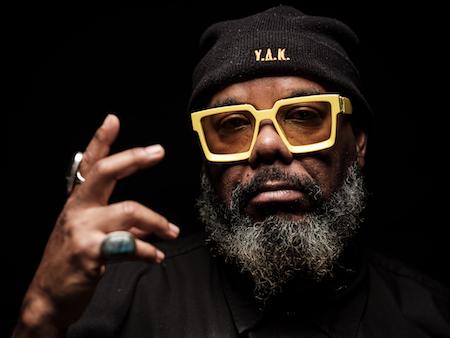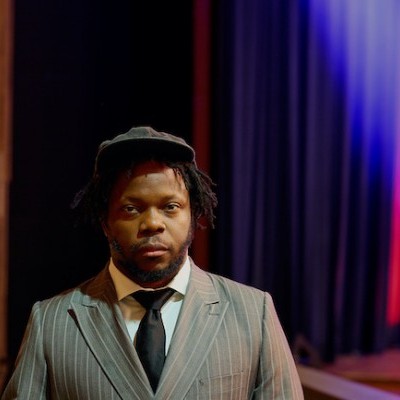Apr 2, 2024 12:59 PM
Saxophonist, Sonic Explorer Casey Benjamin Dies at 45
Casey Benjamin, the alto saxophonist, vocalist, keyboardist and producer who stamped his distinctive sounds on the…

“The amazing thing that I see of great musicians on stage is their ability to utilize their lexicon of languages,” says Kokayi.
(Photo: Bill Lee)Kokayi loves languages. He’s fascinated with the spoken and musical in equal measure. In addition to his native tongue of English, he can navigate through conversations, spoken in German, French, Spanish and Portuguese. He hopes to expand his lexicon with Amharic, Cantonese and Arabic languages.
As a world-renowned rapper and producer, Kokayi demonstrates his ingenuity at accessing a wealth of vocabulary from many languages then applying them into musical contexts that range from boom-bap hip-hop to modern jazz.
“My thought process is that each musician has a lexicon of languages — there are the notes that exist and the relationships with each other,” Kokayi says during an interview in the lobby of the Eaton Hotel in our nation’s capital. “The pedagogy often taught in school is the relationships between the notes and how one flips them on their heads. The amazing thing that I see of great musicians on stage is their ability to utilize their lexicon of languages.”
Born Carl Walker in Washington, D.C., he powers his menthol-flavored, sometimes twangy voice through supple rhymes, brimming with clear enunciation, melodic and thematic cogency, and improvisational swing and swagger.
Kokayi’s just returning from Miami, where he was performing with Terri Lyne Carrington at the African Heritage Cultural Arts Center. He was featured on Carrington’s stellar 2019 album Waiting Game with her Grammy-winning Social Science ensemble. In Miami, he replaced drummer, rapper and DJ Kassa Overall in Carrington’s group.
In addition to performing “Purple Mountains,” a song addressing various atrocities suffered by Native Americans, Kokayi played up his burgeoning talents as a DJ by running various samples during the performance. In addition to applauding Kokayi’s deeply informed rhymes, Carrington admires his improvisational flexibility.
“What’s beautiful about Kokayi in a live setting is [that] it’s truly different every time, because his level of improvising is just as high as his instrumentalist peers,” Carrington says. “He improvises with words on the spot, also with rhythm and melody. He’s not just a poet and rapper; he’s a vocalist, too. And when you add his being able to create electronic textures as well, it makes him a triple threat.”
Note that both Kokayi and Carrington characterize his musicality as “vocalist” instead of the comparatively narrower designation “rapper.” “Though I’m an emcee at heart,” he says, “I chose the word ‘vocalist.’”
Kokayi recalls performing at the Village Vanguard in 2018 with Steve Coleman’s Five Elements and billing himself as “wordsmith,” because Lorraine Gordon, the Vanguard’s proprietor, reportedly didn’t like rappers and didn’t want any performing in the club.
“That was my only time performing at the Village Vanguard,” Kokayi recalls. “Steve told Lorraine that I was a ‘wordsmith’ so that she would allow me to perform on stage. After our first set, she came up to me and said, ‘That was beautiful.’”
Three decades ago, Kokayi first made major impressions on the jazz scene by appearing on Steve Coleman and Metrics’ mid-’90s albums A Tale Of 3 Cities and The Way Of The Cipher, and supporting tours.
Kokayi came into Coleman’s orbit by way of producer Ezra Greer, who was also based in D.C. At the time, Kokayi was an inspiring D.C. rapper, working with the Freestyle Union collective, which also included Terence Nicholson (a.k.a. Sub-Z). Greer asked if the two would like to participate in recording an album in New York. The two hopefuls said yes with guarded optimism.
Greer invited Kokayi and Sub-Z to his house to rhyme over some beats prior to journeying to New York. The beats were in a standard 4/4 meter, according to Kokayi, instead of any of the intrepid meters for which Coleman is renowned.
Two weeks later, they were in Brooklyn at Systems II studio, joining fellow rappers Shahliek, Utasi and Black Thought (of the Roots) to work with Coleman. Although Kokayi grew up in a musically rich household that included a fair share of jazz, he wasn’t familiar with Coleman’s work prior to the encounter.
Nevertheless, Kokayi and the others etched their written rhymes in the studio for the Coleman project. Shortly thereafter, Kokayi and his emcees were whisked off on tour with Coleman. But unlike the 4/4 beats they had originally worked both in D.C. and in the studio, in concert, Coleman’s band — which included Ravi Coltrane, Ralph Alessi, Andy Milne, Reggie Washington and Michael Wimberly — engaged in the hypnotic yet polyrhythmic wizardly for which he’s most acclaimed. At first, Kokayi tried to apply his written rhythms on stage, but was constantly getting lost.
“The thing about Steve, which is hilarious, is that none of the stuff that we did on the record was what we played while we were on tour,” Kokayi recalls. “All of those 4/4 beats that I got happy with just went out the window. The first gig we did, Steve’s in 7/12 or 35 — I don’t know where he was [metrically], but I was trying to say these rhymes over these intricate beats, and I was getting stuck. The first three or four gigs, it was a fumble.”
After about the fourth show, Kokayi told Sub-Z that he was not going to stick to his written rhymes in favor of freestyling. Still, Kokayi had to learn the band’s music. So, he consulted Coleman for direction. Coleman, in turn, directed Kokayi to talk with Lake and Washington about the rhythmic elements of his intricate music.
“I always encourage musicians who I am starting to work with to communicate with the other, more experienced members of my ensemble,” Coleman explains. “The reason is simple: We work with some unusual musical structures and movements. It helps everyone to understand how these sounds move. The most important thing is to listen carefully. But talking to the more experienced musicians helps, because you can get different points of view regarding the music.”
“Once I started learning the parts, it made it easier for me to rhyme over it,” Kokayi says. “My freestyling got exceptionally better. By the time I’m finishing that first whole tour, I came back to D.C. to rap with the regular cyphers, rhyming over 4/4 beats, and I’m killing everybody.”
Since then, Kokayi has collaborated with an elite stream of jazz artists that includes Ambrose Akinmusire, Jamie Baum, Dafnis Prieto, Omar Sosa, Nate Smith, Paolo Fresu and Morgan Guerin. Kokayi has also recorded and toured with the underground hip-hop band Opus Akoben,and released a handful of solo albums.
In July, Kokayi releases his latest album, Kokayi: an eponymous jont, of which its making was supported by a Guggenheim Fellowship. The album embodies the central question of Kokayi’s Guggenheim Fellowship thesis: “What does it feel like to create music with empathy?”
An eponymous jont features Kokayi collaborating with drummer Guillermo Brown, bassist Solomon Dorsey and keyboardist Wynne Bennett in spontaneous collective live composing, resulting in an album containing 100% improvised music and lyrics with no rehearsals and no overdubs. All the songs on the album are first takes.
“We coalesced on some central themes even in how the music sounds and the narratives that goes along with them,” Kokayi explains. “That’s the experiment: What do we do when we start letting the language of what we do as musicians and me as a vocalist take over as opposed to creating songs for a playlist?”
The results are exemplary of spontaneous ingenuity as Kokayi waxes philosophically over several themes that include the pitfalls of self-medicating, the dangers of becoming a workaholic and contemplations on making the wisest career move. In each case, he unspools elaborate anecdotes and observations that take on the bristling yet winding logic of a heated David Murray solo.
Last year, Kokayi showed the world that he’s also a master of the written language by releasing his hilarious but sagacious book, You Are Ketchup (Backbeat Press), which Kokayi describes as a guide for any artists trying to navigate the music business. He uses recollections from his own trajectory, noting the elation then disappointment of getting signed to a major record label then getting dropped, as well as the pragmatic tips for greater sustainability.
As for the title? Kokayi tells artists that they are “ketchup” for the money-making industries. “In the music business, you are about as important to the record label and the industry as a packet of ketchup,” he says. “You are a condiment. You’re sauce for the fries.”
And while he doesn’t define “the fries,” the “sauce” is someone’s individual voice. “Your flavor of ketchup should always be unique,” he advises. “What happens with most artists is that they believe that they are special because they do the vocation. There must be something else about you to be special. And if you don’t know what that special thing is, someone else is going to tell you what makes you special. And that’s how you get pimped out in this game.”
“Once you figure out the unique flavor of your sauce, you can lean into what makes you special,” he concludes. “Superstars are superstars because they understand the sauce that they bring.” DB

Benjamin possessed a fluid, round sound on the alto saxophone, and he was often most recognizable by the layers of electronic effects that he put onto the instrument.
Apr 2, 2024 12:59 PM
Casey Benjamin, the alto saxophonist, vocalist, keyboardist and producer who stamped his distinctive sounds on the…

Albert “Tootie” Heath (1935–2024) followed in the tradition of drummer Kenny Clarke, his idol.
Apr 5, 2024 10:28 AM
Albert “Tootie” Heath, a drummer of impeccable taste and time who was the youngest of three jazz-legend brothers…

Sanborn’s highly stylized playing and searing signature sound — frequently ornamented with thrill-inducing split-tones and bluesy bent notes — influenced generations of jazz and blues saxophonists.
May 14, 2024 3:13 PM
David Sanborn, the star alto saxophonist who masterfully straddled the realms of straightahead jazz, R&B, rock and…

Henry Threadgill performs with Zooid at Big Ears in Knoxville, Tennessee.
Apr 9, 2024 11:30 AM
Big Ears, the annual four-day music celebration that first took place in 2009 in Knoxville, Tennessee, could well be…

“I’m also at a point in my life where I don’t feel like I have anything to prove, like at all,” Akinmusire says about his art.
Mar 26, 2024 12:45 PM
At the risk of oversimplifying and romanticizing the story, Ambrose Akinmusire came bursting on the jazz scene at the…